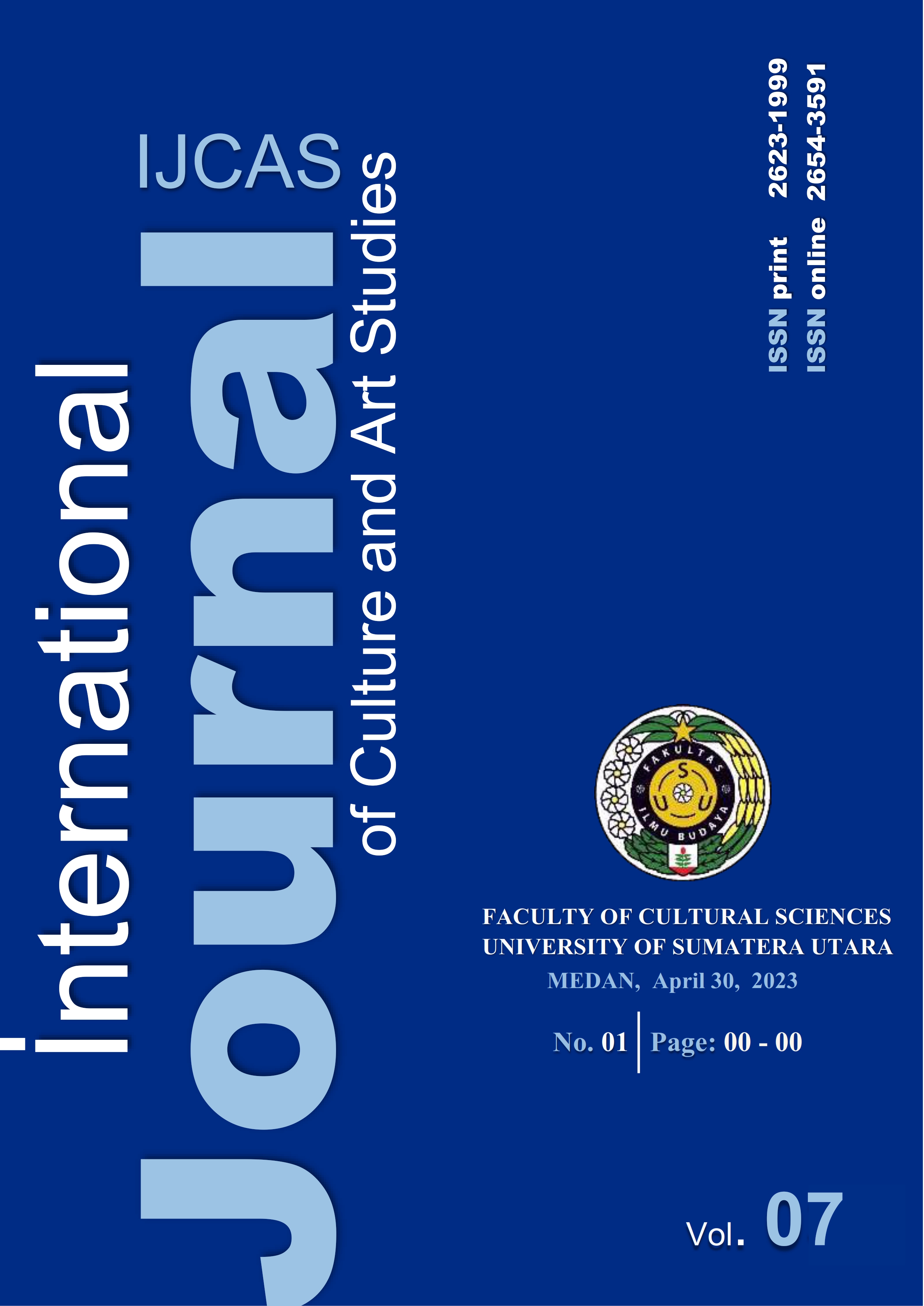The Lioness of African Music: Cultural Interpretation of Wiyaala’s Stage Costume Art
DOI:
https://doi.org/10.32734/ijcas.v7i1.10463Keywords:
Culture, Costume art, The lioness of African music, Stage performance, WiyaalaAbstract
In stage performance, costume art is an essential visual signature device with the veracity to unveil the character and cultural identity of the performer. Stage costume art could also be deployed to respond to pertinent societal issues. In spite of its versatile essentiality in performing arts, there seems to be a dearth of scholarly interpretation of stage costume art of Ghanaian musicians, thereby creating a knowledge gap. This qualitative case study makes a hermeneutical interpretation of eight random-purposively sampled stage costumes of Wiyaala (a Ghanaian female musician) to establish their cultural symbolism. The study found Wiyaala not only an iconic Ghanaian artiste but an internationally recognised musician who toured many countries across Africa, Europe, the Americas, and other continents for musical stage performances. It emerged that Wiyaala’s stage costumes were locally self-constructed, and ably reflected the uniquely versatile indigenous African (Ghanaian) dress cultural identity in respect of African (Ghanaian): royal dress fashion, war costumes, initiation costumes, and others. Wiyaala could be said to have prioritised interest in using her locally sourced stage costume art to promote and preserve indigenous African (Ghanaian) dress cultural identity. Since Wiyaala is an iconic musician, she is encouraged to continue deploying locally sourced costume art for her stage performances to promote and preserve African (Ghanaian) dress cultural identity for posterity. This tends to decolonise the stage costume choice of many Ghanaian musicians with its cascading impact on the Ghanaian textile and fashion industry for economic and job gains.
Downloads
References
Abbey, A. E., Mate-Kole, C. C., Amponsah, B. & Belgrave, Z. F. (2021). Dipo rites of passage and psychological well-being among Krobo adolescent females in Ghana: A preliminary study. Journal of Black Psychology, 1-14.
Abuku, M. & Odi, C. (2011). Costume and make up in cultural development. Creative Artist: A Journal of Theatre and Media Studies, 6(1), 188-201.
Acquaah, S., Amissah E. R. K. & deGraft-Yankson, P. (2017). Dress aesthetics of smock in northern Ghana: Form, function, and context. Journal of Textile Engineering & Fashion Technology, 1(2), 68‒77.
Adjei, A. D. & Osei-Sarfo, F. (2016). Significance of the costume used for the Dia war dance by the Frafra people of the upper east region of Ghana. Journal of Culture, Society and Development, 24, 44-50.
Adinku, U. G. (2016). Dipo: The Krobo Ghanaian puberty rite and art. Matatu 48(2016), 450-474.
Adjaye, K. A. (1999). Dangerous crossroads: Liminality and contested meaning in Krobo (Ghana) dipo girls’ initiation. Journal of African Cultural Studies, 12(1), 5-26.
Agaasa, L. & Ampa-Korsah, H. (2016). Feok festival costumes: Evolution & sociocultural importance. Journal of Culture, Society and Development, 24, 61-65.
Agrey, G. L. (2014). Philosophical hermeneutics: A tradition with promise. Universal Journal of Educational Research 2(2), 188-192.
Akrong, K. N. R. I (2012). Hip life music: Re-defining Ghanaian culture (1990-2012) (PhD dissertation). York University.
Allen, R. C. M. (2014). Shaka Zulu’s linkage of strategy and tactics: An early form of operational art? United States Army Command and General Staff College.
Ampomah, K. (2014). An investigation into adowa and adzewa music and dance of the Akan people of Ghana. International Journal of Humanities and Social Science, 4(10), 117-124.
Annila, P. (2014). Film costumes as icons: Three representations of a hero’s iconic film costume (Master’s Thesis). University of Lapland.
Aris, G. (2007). The power and politics of dress in Africa. Undergraduate Humanities Forum, 2006-7(1), 1-18.
Atampugre, B. (2018). Smock weaving as an avenue for self-employment in upper east region: Case study of Bolgatanga municipality (Master of Technology Thesis). University of Education, Winneba.
Avotri, K. V. N. (2009). The bead culture among the Krobo of Ghana (PhD Thesis). Kwame Nkrumah University of Science and Technology.
Barbieri, D. & Pantouvaki, S. (2016). Towards a philosophy of costume. Studies in Costume & Performance, 1(1), 3-7.
Barrett, J. F., Powley, H. E. & Pearce, B. (2011). Hermeneutic philosophy and organizational theory. Research in the Sociology of Organizations, 32, 181–213.
Boakye, A. P. (2010). Dipo: A rite of passage among the Krobos of eastern region, Ghana (Master of Philosophy Thesis). University of Tromsø.
Botchway, D. N.Y.M. (2018). The hairs of your head are all numbered: Symbolisms of hair and dreadlocks in the Boboshanti order of Rastafari. Africology: The Journal of Pan African Studies, 12(8), 20-38.
Davey, N. (2002). Hermeneutics and art theory. Blackwell Publishers Ltd.
Davidson, W. J. & Correia, S. J. (2001). Meaningful musical performance: A bodily experience. Research Studies in Music Education, 17, 70-83.
Dean, E. S. (2011). Somatic movement and costume: A practical, investigative project. Journal of Dance & Somatic Practices 3(1-2), 167–182.
Dennis, A. (2018). Promoting Ghana’s traditional cultural aesthetics in Ghana’s most beautiful reality television show. Legon Journal of the Humanities, 29(2), 176- 196.
Dennis, A. (2022). Artistic expressions with the use of costumes in selected Ghanaian video films: The freedom and responsibilities of the costumier as an artist. Journal of African History, Culture and Arts, 2 (3), 176-188.
Djokpe, M. K. (2020). The role and place of music in Dipo ceremony amongst the Krabo people of Ghana: A cultural exploration. Research Journal in Advanced Humanities, 1, 8-17.
Dordzro, Y. J. (2017). Impact of Ghanaian basic school band directors ‘rehearsal strategies on students ‘performance (PhD Thesis). University of Cape Coast.
Dzramedo, E. B. (2009). Clothing and fashion in Ghanaian culture: A case study among the Akans (Doctor of Philosophy Thesis). Kwame Nkrumah University of Science and Technology.
Eicher, B. J. (1972). African dress as an art form. A Current Bibliography on African Affairs, 5(II), 516-520.
Entsua-Mensah, E. T. (2015). African music historiography: The case of Ghana. Global Journal of Arts Humanities and Social Sciences, 3(2), 37-42.
Essah, S. D. (2008). Fashioning the nation: Hairdressing, professionalism and the performance of gender in Ghana, 1900-2006 (Doctor of Philosophy dissertation). The University of Michigan.
Essel, O. Q. & Amissah, E. R. K. (2015). Smock fashion culture in Ghana's dress identity-making. Historical Research Letter, 18, 32-38.
Eze, C. P. & Akas, N. C. (2015). Costume and make up, as a tool for cultural interpretation: A study of Egba festival of the Kokori, Isoko local government area of Delta state. Arts and Design, 36, 22-34.
Griffiths, K. N. (2009). The role of concert dress in the performances of solo female classical instrumentalists (PhD Thesis). University of Sheffield.
Guba, E.G. & Lincoln. Y.S. (1989). What is this constructivist paradigm anyway? Sage Publications.
Guignon, C. (2003). Meaning in the work of art: A hermeneutic perspective. Midwest Studies in Philosophy, XXVII, 1-44.
Howard, E. K., Ayesu, S. M. & Amoah, E. B. (2016). The impact of the Ghana movie and music industry on the promotion of locally-made textiles and fashion. International Conference on Applied Sciences and Technology (ICAST), 144-153.
Jing, J. (2021). Analysis of fashion in film and television works. Advances in Social Science, Education and Humanities Research, 631, 1502- 1505.
Jung, J. (2015). A study of the costumes and make-up in the movie "Anna Karenina". J. Fash. Bus., 19(3),14-30.
Kudonu, L. K., Coffie, M. M. & Konu, S. H. (2021). Local dimension band and the cultural revival in Ghanaian popular music. International Journal of Music Studies, 3(1),14-36.
Kwakye-Opong, R. (2014). Archeological and historic survey of Ga costumes: 15th-18thcentury. Historical Research Letter, 11, 25-40.
Kwakye-Opong, R. & Adinku, U. G. (2013). Costume as medium for cultural expression in stage performance. Arts and Design Studies, 8, 9-18.
Le, J. A. (2018). The language and culture of costume design (Master of Fine Arts Thesis). University of California.
Lublin, I. R. (2003). Costuming the Shakespearean stage: Visual codes of representation in early modern theatre and culture (PhD Dissertation). The Ohio State University.
Morgan, C. & Malva, F. (2013). Activating the inanimate: Visual vocabularies of performance practice. Inter-Disciplinary Press.
Nakamura, T. (1987). The communication of dynamics between musicians and listeners through musical performance. Perception & Psychophysics, 41(6), 525-533.
Navei, N. (2023). Youth participation in traditional cultural practices in contemporary Tumu: An exposé on the ceremonial costume art of Fuowie Nasolo, a youth cultural iconic figure in Tumu. Journal of African History, Culture and Arts, 3(1), 13-28.
Navei, N. (2021). Ethnographic and costume regalia of Paari-gbiele festival in northern Ghana. International Journal of Research and Scientific Innovation, 8(7), 38-47.
Nikoi, K. N. (2019). Hiplife music in Ghana: Postcolonial performances of modernity (Ph Dissertation). University of Massachusetts Amherst.
Noland, A. (2015). The being of art and the art of being: Hermeneutic ontology in Gadamer and Woolf (Doctor of Philosophy Thesis). University of Louisville.
Okadigwe, N. M. (2016). Semiotic reading of costumes in Nigerian video films: African bride as a paradigm. Creative Artist: A Journal of Theatre and Media Studies, 10(1), 82-108.
Ostrow, C. (2011). Dipo and other rites of passage in Odumase Krobo. Independent Study Project (ISP) Collection, 1106, 1-37.
Palmer, C. (1997). Music performance. Annu. Rev. Psyc, 48, 115-138.
Panahbar, E. & Dabagh, A. (2012). Philosophical hermeneutics: A path to intercultural understanding through translation. Mediterranean Journal of Social Sciences, 1, 453-460.
Pantouvaki, S., Fossheim, I. & Suurla, S. (2021). Thinking with costume and material: A critical approach to (new) costume ecologies. Theatre and Performance Design, 7(3-4), 199-219.
Peires, J. (2009). Shaka the great. Historia 54(1), 159-179.
Persson, S. R. (1993). The subjectivity of musical performance: An exploratory music psychological real world enquiry into the determinants and education of musical reality (PhD Thesis). University of Huddersfield.
Phothongsunan, S. (2010). Interpretive paradigm in educational research. Galaxy: The IELE Journal, 2(1), 1-4.
Pyne, S. (2009). Implications for the use of indigenous arts in the therapeutic practices of traditional priests and priestesses of Asante Ghana (Doctor of Philosophy Thesis). Kwame Nkrumah University of Science and Technology.
Rasool, S. (2018). What is hermeneutics? IJCRT, 6(1), 211- 226.
Roberts, C. O. (2019). The influence of costumes on the perception of dance: Review. IAA Journal of Applied Sciences 5(1):58-63.
Schutz, A. (1967). The phenomenology of social world. Northwestern University Press.
Shields, A. B. (2012). Adorning the story: Costume as a storytelling tool in Alfred Hitchcock’s stage fright and strangers on a train (Master of Science Thesis). The University of Georgia.
Sieber, R. & Herreman, F. (2000). Hair in African art and culture. African Arts, 33(3), 54-96.
Sika, A. W. (2016). Costume aesthetics: found objects as dressing in the production of the Slaves Mamiya (Master of Fine Art Thesis). University of Ghana.
Tomaselli, G. K. (2003). Shaka Zulu, visual history and television. South African Humanities,15, 91-107.
Turner, V. (1987). The Anthropology of performance. PAJ Publications.
Ugwu, C.I., Ekere, J. N. & Onoh, C. (2021). Research paradigms and methodological choices in the research process. Journal of Applied Information Science and Technology 14(2)2021.
Worger, W. (1979). Clothing the dry bones: The myth of Shaka. Jounal of African Studies, 6(3), 144-158
Zhang, W. (2015). Applications research of dancing costumes in national dance. International Conference on Economy, Management and Education Technology, 70-72.
Downloads
Published
How to Cite
Issue
Section
License
Copyright (c) 2023 Nyamawero navei

This work is licensed under a Creative Commons Attribution-ShareAlike 4.0 International License.













